Bio H - Chapter 4 notes
in class lectures:
the cell membrane:
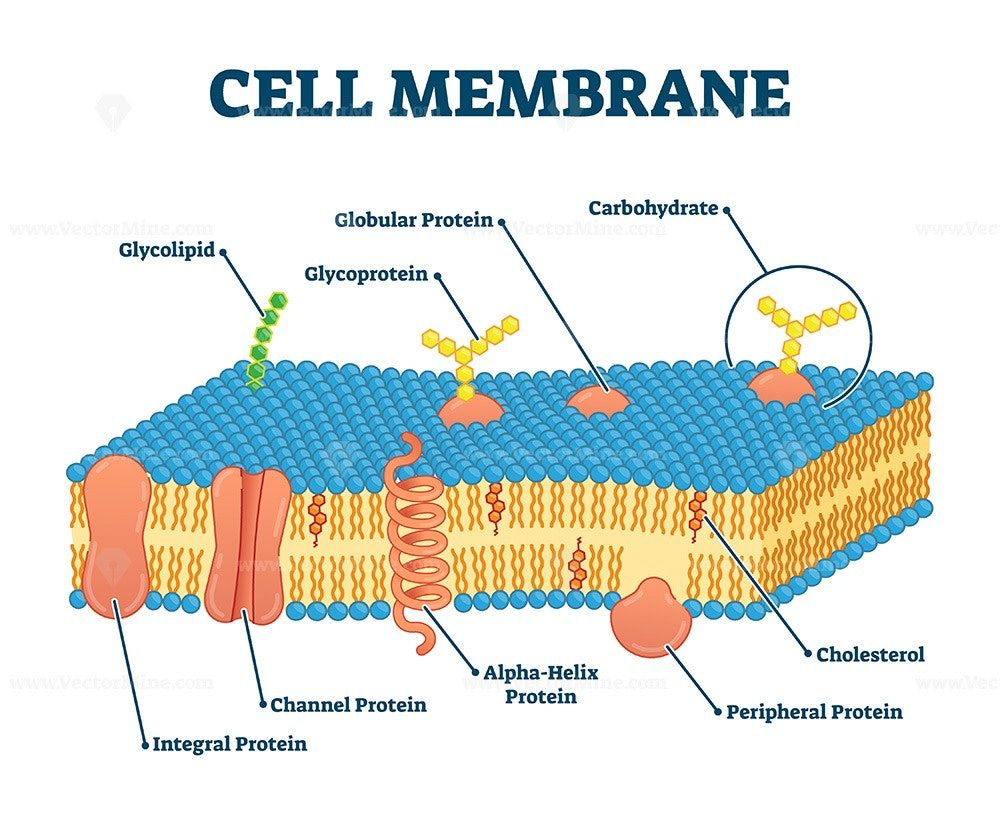
phospholipids -----
phosphate head: hydrophilic, attracted to water
fatty acid tails: hydrophobic, repelled by water
arranged as a bilayer
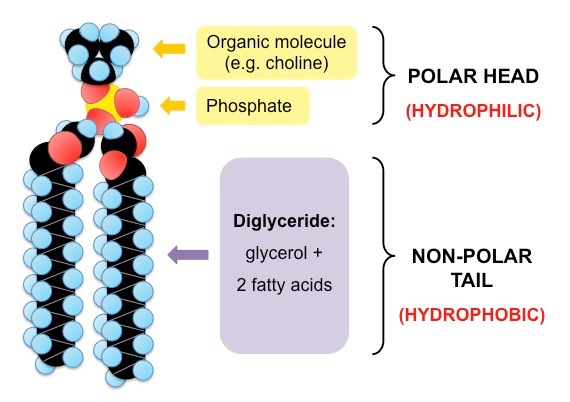
phospholipid bilayer: arranged, serves as a cellular barrier/border, only lipids can get through, impermeable to polar molecules

the cell membrane defines the cell -
cell membrane separates living cell from aqueous environment
thin barrier = 8nm thick
controls traffic in and out of the cell
allows some substances to cross more easily than others
hydrophobic (nonpolar) vs hydrophilic (polar)
permeability to polar molecules??
membrane becomes semi-permeable via protein channels
specificchannels allow specific material across membrane

cell membrane is more than lipids…
transmembrane proteins embedded in the phospholipid bilayer
create semi-permeable channels
why are proteins the perfect molecule to build structures in the cell membrane??
made up of amino acids, amino acids have different r groups, different functions and different polarities
nonpolar, hydrophobic
polar, electrically charged, acidic and basic are all polar and hydrophilic

proteins domains anchor molecule
within membrane - nonpolar amino acids, hydrophobic, anchors protein into membrane
on outer surfaces of membrane in fluid - polar amino acids, hydrophilic, extend into extracellular fluid and into cytosol (liquid stuff in the cell, cell’s solution)
these are the channels that let things pass through
examples -
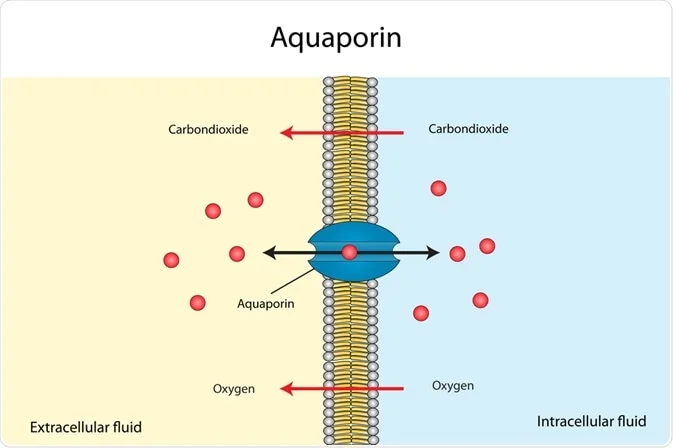
functional through conformational change = protein changes shape
many functions of membrane proteins
transporter - channel
enzyme activity
cell surface receptor
cell surface identity maker - antigen
cell adhesion
attachment to the cytoskeleton
membrane proteins
proteins determine membrane’s specific functions
the cell membrane and organelle membrane each have unique collections of proteins
classes of membrane proteins:
@@__peripheral proteins:__@@ loosely bound to surface of membrane, ex. cell surface identity marker (antigens) @@__integral proteins:__@@ penetrate lipid bilayer, usually across whole membrane, transmembrane protein ex. transport proteins channels, permeases (pumps)
cell membrane must be more than lipids..
in 1972 S.J. Singer and G. Nicolson proposed that membrane proteins are inserted into the phospholipid bilayer
membrane is a collage of proteins and other molecules embedded in the fluid matrix of the lipid bilayer
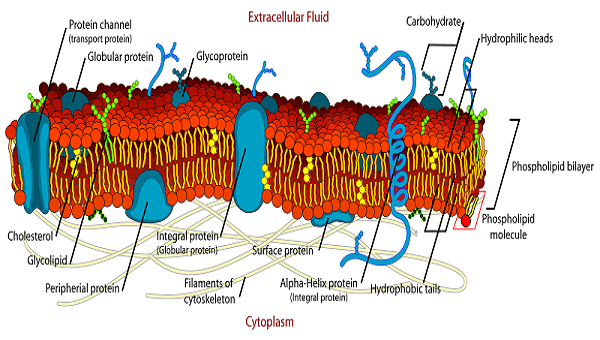
membrane carbohydrates
play a key role in cell-cell recognition
ability of a cell to distinguish one cell from another, antigens ex. heart transplant, ability to not take anti-rejection drugs for the rest of their lives important in organ and tissue development basis for rejection of foreign cells for the immune system
movement of the cell:
diffusion
2nd law of thermodynamics, governs biological systems
universe tends toward disorder (entropy)
diffusion is the movement from high → low concentration

simple diffusion
move from high to low
“passive transport” - **@@no energy needed!!!@@**
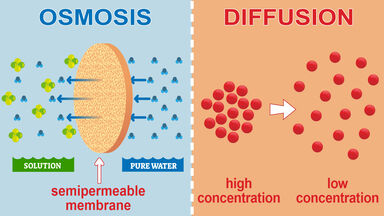
facilitated diffusion
diffusion through protein channels
channels move specific molecules across cell membrane, **@@no energy needed!!!@@** __facilitated__ = with help __open channel__ = fast transport
active transport
cells may need to move molecules against concentration gradient
conformational shape change transports solute from one side of membrane to another
protein “pump”
“costs” energy = ATP
low to high
many molecules and mechanisms
antiport uses ATP
 getting through cell membrane
getting through cell membrane
passive transport
simple diffusion
diffusion of nonpolar, hydrophobic molecules
lipids
high → low concentration gradient
facilitated transport
diffusion of polar, hydrophilic molecules
through a protein channel
high → low concentration gradient
active transport
diffusion against concentration gradient
low → high
uses a protein pump
requires ATP
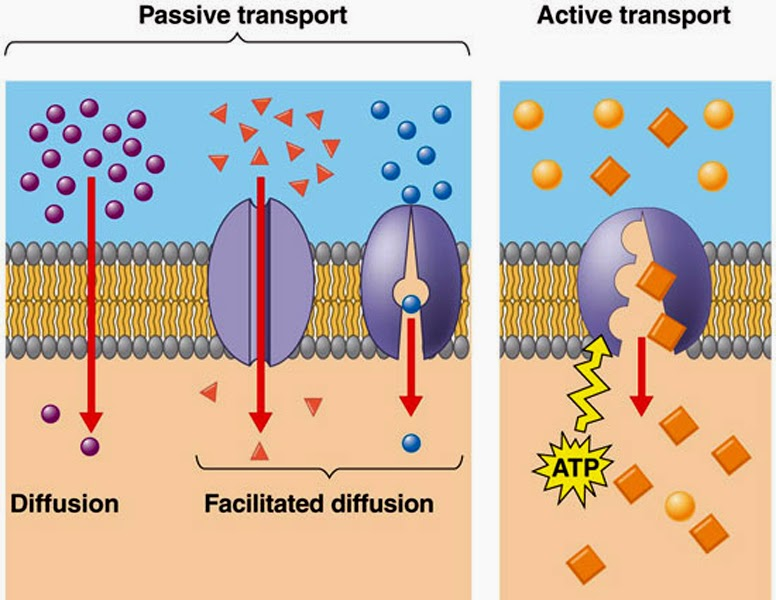

what molecules cannot get through directly:
polar
h2o
charged ions
salts, ammonia
large molecules
membrane fat composition varies
fat composition affects flexibility
membrane must be fluid and flexible
about as fluid as thick salad oil
% unsaturated fat acids in phospholipids
keep membrane less viscous
cold adapted organisms, like winter hear
increase % in autumn
cholesterol in membrane
diffusion across cell membrane
cell membrane is the boundary between inside and outside…
seperates cell from its environment
can it be an impenetrable boundary?? no!! stuff has to go in (food, carbs, sugars, proteins, amino acids, lipids, salts, oxygen, water) and out (waste)
cell needs materials to go in and out
tour of the cell 1:

 types of cells: plant, animal and bacteria
types of cells: plant, animal and bacteria
prokaryote bacteria cells
no organelles
1-3 flagella (tail things)
eukaryote plant and animal cells
organelles
why organelles?
specialized structures
specialized functions
cilia or flagella for locomotion
containers
partition cell into compartments
create different local environments
separate pH or concentration of materials
distinct and incompatible functions
lysosome and its digestive enzymes
membrane as sites for chemical reactions
unique combinations of lipids and proteins
embedded enzymes and reaction centers
chloroplasts and mitochondria
cells got to work to live!
what jobs do cells have to do?
make proteins
proteins control every cell function
make energy
for daily life
for growth
make more cells
growth
repair
renewal
building proteins:
proteins do all the work!
dogma: DNA → replication → RNA → protein → phenotype
cell functions
building proteins
read DNA instructions
build proteins
process proteins
folding
modifying
removing amino acids
adding other molecules
ex. making glycoproteins for the cell membrane
address and transport
building proteins
organelles involved
nucleus → ribosomes → ER → Golgi apparatus → vesicles
cell structure and function:
nucleus
function
protects DNA
structure
nuclear envelope
double membrane
membrane fused in spots to create pores
allows large macromolecules to pass through
DNA comes from the nucleus

*****nucleolus
functionribosome productionribosomes come from the nucleolusribosomes**functionprotein productiontypes of ribosomesfree ribosomesuspended in cytosolsynthesize proteins that function in cytosol
ERfunctionprocesses proteinsmanufactures membranessynthesis and hydrolysis of many compoundsstructuremembrane connected to nuclear envelope and extends throughout the cell
smooth ER functionmembrane productionmany metabolic processessynthesissynthesis lipidsoils, phospholipids, steroids and sex hormoneshydrolysishydrolyze glycogen into glucose
in liver
detoxify drugs and poisons
in liver
ex. alcohol and barbiturates
**rough ER function
**produce proteins for export out of the cellprotein secreting cells
packaged into transport vesicles for export
**membrane factory
**build new membranesynthesize phospholipidsbuilds membraneER membrane expandsbud off and transfer to other parts of cell that need membranes
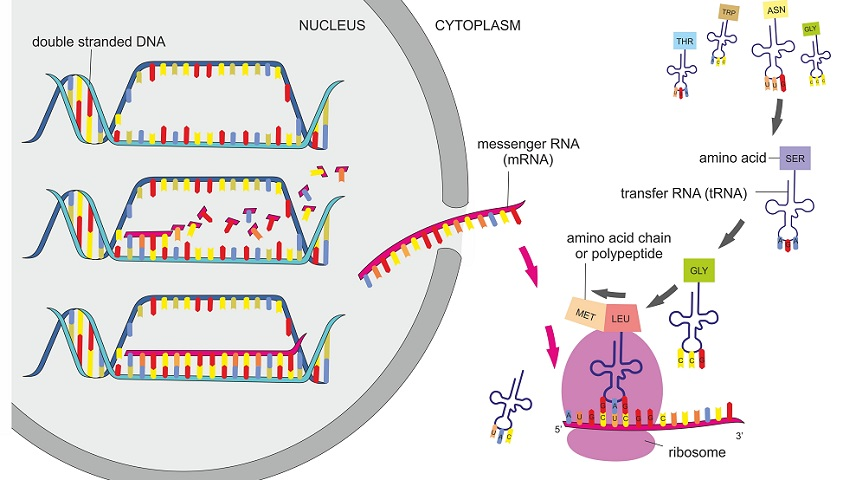
synthesizing proteins****golgi apparatusfunctionfinishes, sorts, tags and ships cell productslike UPS shipping departmentships products in vesiclesmembrane sacslike ups trucks
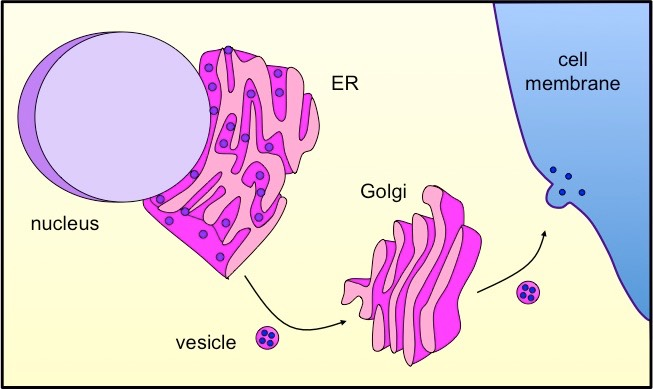

vesicle transport****making proteinsinsert diagramnucleus with DNA → RNA (transcribe) → translation, rough ER with ribosomes → take MRNA to make amino acid sequence → make protein → amino acid sequence → send vesicle out to the golgi apparatus → modified → make tertiary structure@@

***KNOW AND LABLE THE PLANT AND ANIMAL CELL@@@@not in animal cells:
@@ chloroplasts, central vacuole and tonoplast, cell wall, plasmodesmatatour of the cell 2:making energy → ATPcells need power!making energytake in food and digest ittake in oxygenmake ATPremove wastelysosomesfunctionlittle “stomach” of the celldigests macromolecules“clean up crew” of the cellcleans up broken down organellesstructurevesicles of digestive enzymessynthesized by rough ER, transferred to golgiwhite blood cells attack and destroy invaders = digest them in lysosomes
cellular digestionlysosomes fuse with food vacuolespolymers digested into monomers
lysosomal enzymeslysosomal enzymes work best at pH5organelle creates custom pHproteins in lysosomal membrane pump H+ ions from the cytosol into lysosomeenzymes are proteins --- pH affects structuredigestive enzymes wont function well if some leak into cytosol
**when things go bad…**diseases of lysosomes are often fataldigestive enzymes not working in lysosomepicks up biomolecules, but can’t digest onelysosomes fill up with undigested materialgrow larger and larger until disrupts cell and organ function@@lysosomal storage diseases
*more than 40 knownexample:Tay-Sachs disease - build up undigested fat in brain cellslysosomal storage diseaseslipidsglycogenproteinssometimes cells do need to dielysosomes can be used to kill cells when they are supposed to be destroyedsome cells have to die for proper development in an organismapoptosis
fetal development, syndactylyapoptosisprogrammed destruction of cells in multi-cellular organismsprogrammed developmentcontrol of cell growthexample - if cell grows uncontrollably this self-destruct mechanism will kick inmaking energycells must convert incoming energy to forms that they can use to workmitochondria
@@: from glucose to ATP, using oxygenchloroplasts: from sunlight to ATP and carbsATP = active energycarbs: restoremitochondria and chloroplastsimportant to see similaritiestransform energygenerate ATPdouble membranes = 2 membranessemi-autonomous organellesmove, change shape, divideinternal ribosomes, DNA and enzymesinsert mitochondria and chloroplast diagramsmitochondriafunctioncellular respirationgenerate ATPfrom breakdown of sugars, fats and other fuelsin the presence of oxygenbreak down larger molecules into smaller to generate energy = catabolismgenerate energy in the presence of o2structure2 membranessmooth outerhighly folded innercristaefluid filled space between 2 membraneswhy 2 membranes?increases surface area
**textbook notes:**4.1 cells@@the cell theory
@@ -all organisms are composed of one or more cellscells are the smallest living thingscells arise only by division of a previous existing cell**why are cells so small?**large cells don’t function as efficientlysmall cells have a greater@@surface to volume ratio *
*radius x 10, SA x 100, volume x 1000surface area must be large enough to meet volume needs4.3 prokaryotic cellsprokaryotes:
@@ have a relatively uniform cytoplasm that is not subdivided by interior membranes into separate compartmentssimplest cellular organismssingle celledinterior has little to no structural support (cell wall supports shape)some prokaryotes use a@@flagellum *
*@@ to movepili are short flagella that occur on some of the cellshelp the prokaryotes attach to substances and aid in genetic information exchange between cellscomponentsribosomesnucleoid regionDNAflagellumcapsulecell wallplasma membranecytoplasmpili@@they lack a nucleus and do not have an extensive system of interior membranes@@4.4 eukaryotic cellsanimal cell components**@@plasma membrane:
@@ lipid bilayer in which proteins are embedded@@cytoplasm:
@@ semifluid matrix that contains the nucleus and other organelles@@mitochondrion:
@@ organelle in which energy is extracted from food during oxidative metabolism@@secretory vesicle:
@@ vesicle fusing with the plasma membrane, releasing materials to be secreted from the cell@@cytoskeleton:
@@ supports organelles and cell shape and plays a key role in cell motion@@microtubule:
@@ tube of protein molecules present in cytoplasm, centrioles, cilia, and flagella@@intermediate filament:
@@ intertwined protein fibers that provide support and strength@@actin filament:
@@ twisted protein fibers that are responsible for cell movement@@nucleus:
@@ command center or the cell@@nucleolus:
@@ site where ribosomes are produced@@nuclear envelope:
@@ double membrane between the nucleus and the cytoplasm@@nuclear pore:
@@ opening embedded with proteins that regulates passage into and out of the nucleus@@endomembrane system
@@@@smooth endoplasmic reticulum:
@@ system of internal membranes that aids in the manufacture of carbohydrates and lipids@@rough endoplasmic reticulum:
@@ internal membranes studded with ribosomes that carry out protein synthesis@@ribosomes:
@@ small complexes of RNA and protein that are the sites of protein synthesis@@peroxisome:
@@ vesicle that contains enzymes that carry out particular reactions such as detoxifying potentially harmful molecules@@centriole:
@@ complex assembly of microtubules that occurs in pairs**plant cell components**@@plasma membrane
@@@@cytoplasm
@@@@mitochondrion
@@@@cytoskeleton
@@@@microtubule
@@@@intermediate filament
@@@@actin filament
@@@@nucleus
@@@@nucleolus
@@@@nuclear envelope
@@@@nuclear pore
@@@@endomembrane system
@@@@smooth endoplasmic reticulum
@@@@rough endoplasmic reticulum
@@@@ribosomes
@@@@golgi complex
@@@@peroxisome
@@@@cell walls
@@@@cell wall:
@@ outer layer in some organisms that provide support@@adjacent cell walls:
@@ in plants, adjacent cell walls are glued together by a very sticky substance between their walls@@chloroplast:
@@ organelle containing thylakoids, the sites of photosynthesis@@central vacuole:
@@ in plants, storage compartment for water, sugars, ions, and pigments@@plasmodesmata:
@@ openings in the cell wall that function in cell to cell communication4.5 - 4.8 overviewstructurefunctionplasma membrane- phospholipid bilayer embedded with proteins, fluid mosaic model, everything moves aroundnucleus- stores DNA, the DNA is isolated by the nuclear envelope which has nuclear pores that control traffic in and out of the cellendoplasmic reticulum- rough ER contains ribosomes that manufacture proteins, smooth ER detoxifies harmful substances or aids in the synthesis of lipidsgolgi complex- molecules pass from the ER to the golgi through vesicles, sorts and packages these molecules and also synthesizes carbohydrates, it then directs the molecules to lysosomes, secretory vesicles, or the plasma membranemitochondrion- “power house of the cell”, harvests energy that is used to drive pumps that synthesize ATP, inner and outer membraneschloroplast- house of the green pigment in plants, inner and outer membranecytoskeleton- made up of actin filament (responsible for cellular movements), microtubules (responsible for facilitating movements and move materials within the cell) , and intermediate filaments (responsible for structural stability)centrioles- barrel shaped organelles in animal cells, occur in pairs and assemble the cell’s microtubules, tjeu also form cilia and flagella4.9 outside the plasma membraneplant cells and other cells have cell walls, which animal cells don’t have, that protect and support cellsprimary wall in plant cells are laid down when the cell is still growing, thinner outer wallsin between is the middle lamella, a sticky substance that glues the cells togethersecondary wall is produced in some cells and are very thick, inside the primary wall4.13 bulk passage in and out of cellsendocytosis and exocytosisendocytosis: the process of the membrane engulfing particles and forming a vesicleexocytosis: the discharge of a material from vesicles at the cell surfacephagocytosis and pinocytosisphagocytosis: material of cells that takes in some other fragment of organic matter (eating)pinocytosis: material that the cell takes in is a liquid or when it dissolves in a liquid (drinking)4.10 - 4.14 transport mechanisms overviewprocesshow it worksexample | passive processesdiffusiondirectrandom molecular motion produces net migration of molecules to a region of lower concentration, @@high → low | |||
movement of oxygen into cellsprotein channelpolar molecules pass through a protein channelmovement of ions in or out of a cellfacilitated diffusionprotein carriermolecule binds to carrier protein in molecule and is transported acrosshigh → low | ||||
movement of glucose into cellsosmosisaquaporinsdiffusion of water molecules across selective permeable membranemovement of water into cells placed in a hypotonic solutionactive processesendocytosis, membrane vesiclephagocytosisparticle is engulfed by membrane, which folds around it and forms a vesicleingestion of bacteria by white blood cellspinocytosisfluid droplets are engulfed by membrane, which forms vesicles around themnursing of human egg cellsrecepter-mediated endocytosisendocytosis is triggered by the binding of a target molecule to a specific receptorcholesterol uptakeexocytosismembrane vesiclevesicles fuse with plasma membrane and eject contentssecretion of mucusactive transport, protein carrierNaK pumpcarrier expends energy to transport a substances across a membrane against its concentration gradientlow → high | ||||
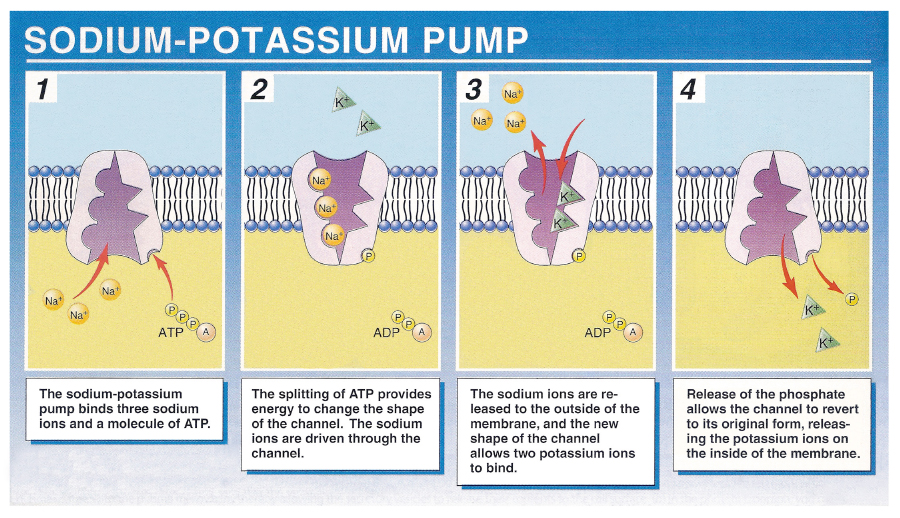
@@movement of Na and K against their concentration gradientscoupled transportmolecules are transported across a membrane against their concentration gradients by the cotransport of another substance down its concentration gradientcoupled intake of glucose into cells against their concentration gradient4.14 active transportsodium potassium pumptextbook chapter summaries:****4.1cells are the smallest living structure, consist of a cytoplasm enclosed in a plasma membrane and organisms can be composed of a single cell or many cellsmaterials pass in and out of the cells across the plasma membrane; surface area to volume ratiomicroscope is needed to study cells because they are so small4.2plasma membrane encloses all cells, consists of a phospholipid bilayer embedded with many different proteins, fluid mosaic modelphospholipids have a polar head and 2 nonpolar tails, formed because nonpolar ends move away from the watery solutions and that creates 2 layers
4.3prokaryotic cells, simple celled, lack nuclei or other internal walls, rigid cell wall, flagella or pili, bacteria cells
4.4eukaryotic cells, plant and animal, much larger, more structurally complex, contain nuclei, organelles and internal membrane systems
4.5nucleus is the command/control center, contains DNA, ribosomal RNA is made in the nucleolus
4.6endomembrane system, collection of interior membranes that divide the cell’s interior into functional areas. proteins are synthesized in the ER then go to the golgi complex. golgi complex → UPS
4.7mitochondrion, site of oxidative metabolism, an energy extracting processchloroplasts, sites of photosynthesis, only in plant and algae cells
4.8interior of the cell contains a network of protein fibers that make up the cytoskeleton. the cytoskeleton supports the cell and anchors organelles in placecentrioles are paired structures that assemble microtubules and vacuoles are storage compartmentsmotor proteins move materials in and out of the cell and the cilia and flagella propel the cell through its environment
4.9the cells of plants, fungi and many protists have cell walls that serve a similar function as prokaryotic cell walls doanimal cells lack cell walls but contain an outer layer of glycoproteins, called the extracellular matrix
4.10materials pass in and out of the cell passively through diffusion, the plasma membrane is selectively permeable because only some molecules can pass through the membrane by passive diffusionmolecules diffuse from an area of high concentration to an area of low concentration, down the concentration gradient
4.11in facilitated diffusion, a substance travels down the concentration gradient but must bind to a carrier protein to pass across the protein
4.12osmosis is the movement of water into and out of the cell driven by differing concentrations of solutewater molecules move to areas of higher solute concentration
4.13larger structures of larger quantities of material move into and out of the cell through endocytosis and exocytosisreceptor-mediated endocytosis is a selective transport process, bringing in only those substances that are able to bind to specific receptors